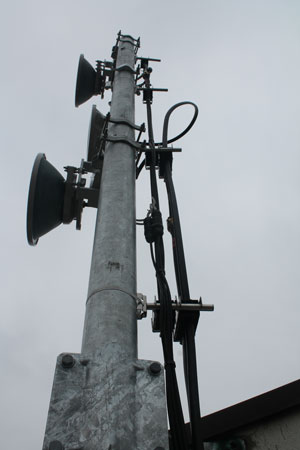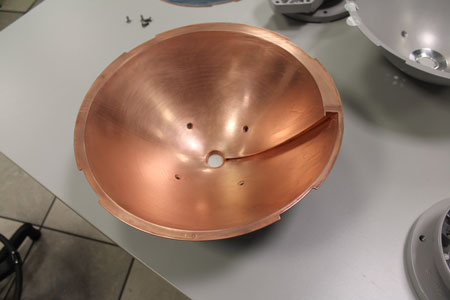On 24 September 2013, Mr François Rancy, Director, BR and Dr Sergio Buonomo, Counselor, ITU-R Study Groups, visited the University of Padua, Italy, to witness an experiment on the application of the Radio Orbital Angular Momentum to radiocommunications.
This concept, if applicable on a large scale, has the potential for drastic improvement in spectrum efficiency and would therefore be revolutionary. Research and development continue to overcome the remaining technical and technological challenges, in particular for the antenna systems.
This concept has been applied for several decades in astronomy and more recently in optics, following the theoretical foundations established nearly a hundred years ago by John Henry Poynting in 1909 and Max Abraham in 1914. These show that the Maxwell equations, which constitute the basic law of electromagnetic waves, admit 10 principal vectorial/pseudovectorial conserved quantities, corresponding to 23 independent scalar conserved quantities. The basic idea is that a signal channel can correspond to the propagation modes of any conserved quantity. Until now only one vectorial quantity, namely linear momentum (associated to Lorentz force), is currently used for radiocommunications, definitively much less than could be possible and that is, at present, required by radiocommunications. Other additional properties, whose physical meaning is still not clear, have been found recently and discussed in the literature.
The Padua University experiment uses one of these principal conserved quantities, the Orbital Angular Momentum (OAM) states carried by electromagnetic waves. For each frequency, an EM wave carrying OAM presents a characteristic natural azimuthal phase periodicity with integer multiples of the round angle. This property permits to establish phase diversity between each radio beam in the same frequency and separate different channels by different OAM states. The radio experiment here discussed demonstrates the possibility to operate over a 150 meter distance, three 54 MHz 4 QAM transmissions on the same frequency (17 GHz) and the same polarization with acceptable mutual interference levels.
Figure 1 shows the transmit antenna group. Figure 2 shows one of the parabolic antennas used to generate the wave using OAM.

Figure 1 - Antenna groups

Figure 2 - Parabolic phase antenna reflector
The ITU delegation met with, Pr. Filippo Romanato, Pr. Francesca Soramel and Dr. Fabrizio Tamburini (University of Padua), Mr Alberto Mascetti and Mr Piero Coassini (SIAE-Microelectronics) and Pr Carlo Someda (Twistoff) together with members of their teams.
The ITU delegation suggested to the developers to present contributions to:
- ITU-R Study Group 3 activities in order to characterize the propagation aspects that may be specific to this type of transmission,
- ITU-R Study Group 5 to consider the overall impact of these transmissions on the current situation of a high degree of frequency sharing between various links and services, in particular the overall capacity gain achievable.
Literature offers results of researches in the above field, some of them are referred below:
- The complete sets of conservation laws for the electromagnetic field [Fuschich, W. I. and Nikitin A. G.], J. Phys. A: Math. Gen. 25 L231, 1992
- Utilization of photon orbital angular momentum in the low-frequency radio domain [Thide’, et al.], Physical Review Letters, 2007
- Experimental verification of photon angular momentum and vorticity with radio techniques [Tamburini, et al.], Applied Physics Letters, 2011
- Encoding many channels on the same frequency through radio vorticity: first experimental test [Tamburini, et al.], New Journal of Physics, 2012